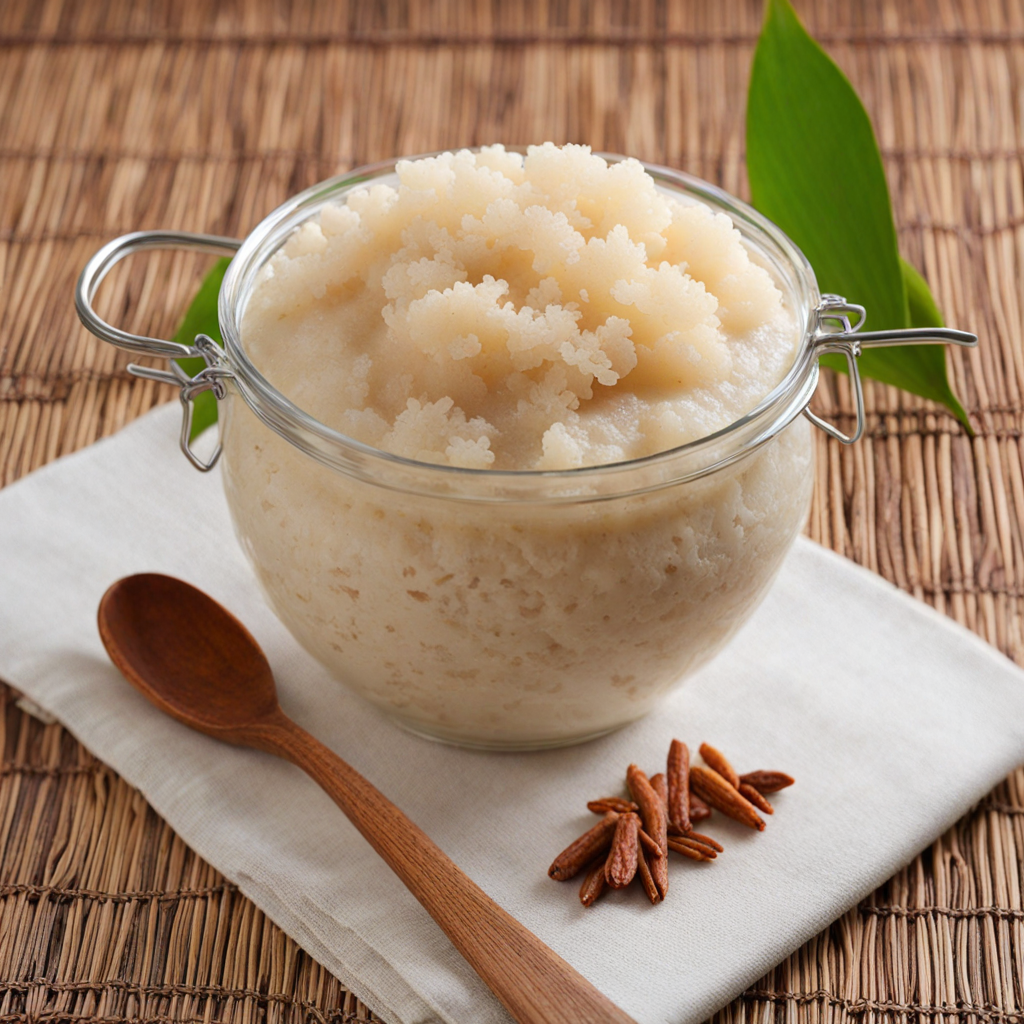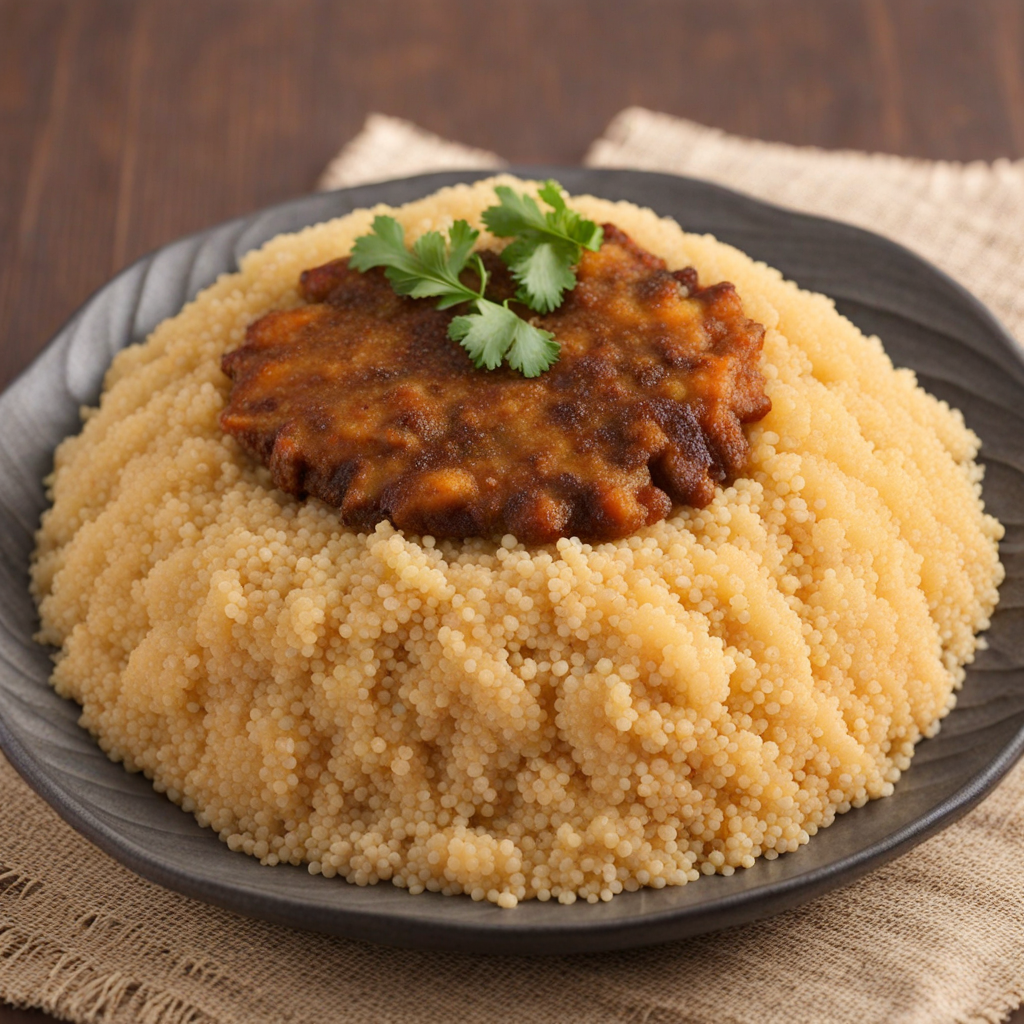Tigadegena
Tigadegena is a traditional Malian dish that showcases the rich flavors and culinary heritage of West Africa. This hearty stew primarily features a base of ground peanuts, which lend a creamy texture and a nutty depth that is both satisfying and unique. The dish is often prepared with a variety of vegetables, including tomatoes, onions, and sometimes leafy greens, creating a vibrant and colorful presentation. The combination of ingredients is simmered to perfection, allowing the flavors to meld beautifully while maintaining the freshness of the vegetables. One of the defining characteristics of Tigadegena is its use of spices, which can vary by region and personal preference. Common spices include garlic, ginger, and chili peppers, which add warmth and complexity to the dish. The addition of meat, often chicken or beef, can further enhance the umami profile, making it a fulfilling meal that appeals to both meat lovers and vegetarians alike. Served with a side of rice or fufu, Tigadegena makes for a comforting and nourishing experience that warms the body and soul. In Mali, Tigadegena is more than just a meal; it is often enjoyed during gatherings and special occasions, embodying the communal spirit of sharing food. Its rich history and cultural significance make it a dish worth exploring for anyone eager to experience the authentic flavors of Malian cuisine. The combination of creamy peanuts, fresh vegetables, and aromatic spices creates a taste that is both familiar and exotic, inviting food enthusiasts to savor a truly unique culinary adventure.
How It Became This Dish
The History of Tigadegena: A Culinary Gem from Mali #### Origins Tigadegena, a savory and aromatic peanut sauce, hails from the rich culinary heritage of Mali, a land steeped in history and culture. The name "Tigadegena" is derived from the Bambara language, one of the most widely spoken languages in Mali, and translates to “the sauce made with groundnuts.” Groundnuts, or peanuts, are indigenous to West Africa and have been cultivated in the region for centuries. Archaeological evidence suggests that peanuts were domesticated in South America, but they made their way to Africa through the transatlantic slave trade and were integrated into local cuisines. Peanuts quickly became a staple ingredient in many West African dishes due to their versatility, nutritional value, and ability to thrive in the region's climate. Tigadegena exemplifies how local ingredients can intertwine with cultural practices, creating a dish that is both comforting and nourishing. #### Cultural Significance In Mali, Tigadegena is more than just a sauce; it is a symbol of hospitality and communal dining. Traditionally served with rice or fufu (a starchy side made from cassava, yam, or plantains), Tigadegena is often enjoyed during family gatherings, celebrations, and religious festivities. The act of preparing and sharing Tigadegena is steeped in tradition, often involving multiple generations of family members, who contribute to the meal in different ways. This collaborative cooking experience fosters a sense of community and strengthens familial bonds. Moreover, Tigadegena is representative of the Malian spirit of resilience and adaptability. Throughout its history, Mali has faced numerous challenges, including colonialism, political strife, and economic hardship. Yet, the Malian people have preserved their culinary traditions, adapting them to changing circumstances while maintaining the essence of their culture. Tigadegena, with its rich flavors and comforting nature, serves as a culinary reminder of the enduring spirit of the Malian people. #### Development Over Time The development of Tigadegena over time reflects the broader socio-political and economic changes in Mali. In its early iterations, Tigadegena was a simple concoction of ground peanuts, spices, and water, used primarily as a dipping sauce or a flavor enhancer for various dishes. As trade routes expanded and cultural exchanges flourished, new ingredients and cooking techniques began to influence the preparation of Tigadegena. During the 19th century, Mali was part of the powerful Mali Empire, which was known for its wealth, trade, and scholarship. The empire facilitated the exchange of goods, ideas, and culinary practices across West Africa and beyond. This era saw the introduction of new spices and ingredients, such as chili peppers, onions, and tomatoes, which began to find their way into Tigadegena, enhancing its flavor profile and making it more complex. The arrival of French colonial rule in the late 19th and early 20th centuries brought further changes to Malian cuisine. French culinary techniques and ingredients began to merge with traditional Malian practices. While some viewed this as an imposition, others embraced the fusion, creating a more diverse culinary landscape. Tigadegena adapted during this time, incorporating new elements while still honoring its roots. In the latter half of the 20th century, post-independence Mali saw a resurgence of interest in traditional foods as a means of cultural identity. Tigadegena became a vehicle for expressing national pride, with chefs and home cooks alike seeking to preserve and elevate this beloved sauce. Various regional variations emerged, with different communities adding their unique twists based on local ingredients and preferences. For instance, some versions of Tigadegena might include smoked fish or meat, while others might focus more on spices. #### Contemporary Adaptations Today, Tigadegena is enjoyed not only in Mali but also in various parts of West Africa and among the diaspora communities around the world. With the globalization of food culture, Tigadegena has found its way into international kitchens, often being featured in African restaurants and fusion cuisine. Chefs are experimenting with Tigadegena, pairing it with non-traditional ingredients and serving it in innovative ways, from gourmet appetizers to hearty main courses. In contemporary Mali, Tigadegena remains a staple in both urban and rural households. It is often prepared for special occasions and family gatherings, embodying both tradition and modernity. The rise of food tourism in Mali has also contributed to the dish's popularity, as travelers seek authentic culinary experiences that connect them to the local culture. Furthermore, the health benefits of Tigadegena, rich in protein and healthy fats from peanuts, resonate with increasingly health-conscious consumers. The dish is celebrated for its ability to provide sustenance while being adaptable to various dietary preferences, including vegan and gluten-free diets. #### Conclusion Tigadegena is more than just a delicious peanut sauce; it is a culinary symbol of Mali's rich heritage, resilience, and adaptability. From its humble beginnings as a simple sauce to its contemporary iterations in global cuisine, Tigadegena tells the story of a people who have navigated challenges while celebrating their cultural identity. As it continues to evolve, Tigadegena remains a cherished part of Malian life, reminding us of the power of food to connect, nourish, and sustain communities across generations. Whether enjoyed in a bustling Malian household or a trendy restaurant in Paris, Tigadegena invites everyone to partake in the warmth and flavors of Mali's culinary legacy.
You may like
Discover local flavors from Mali







